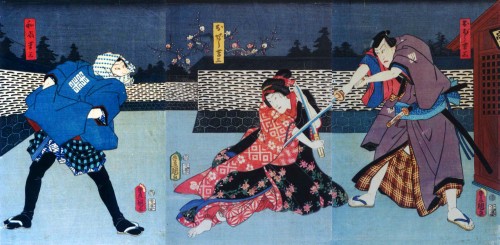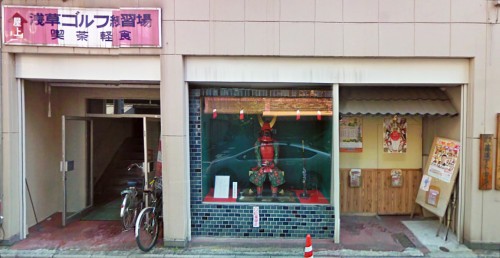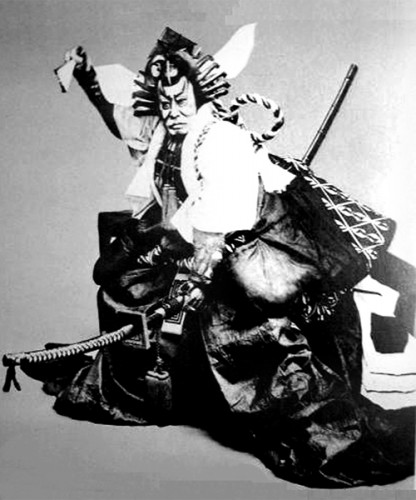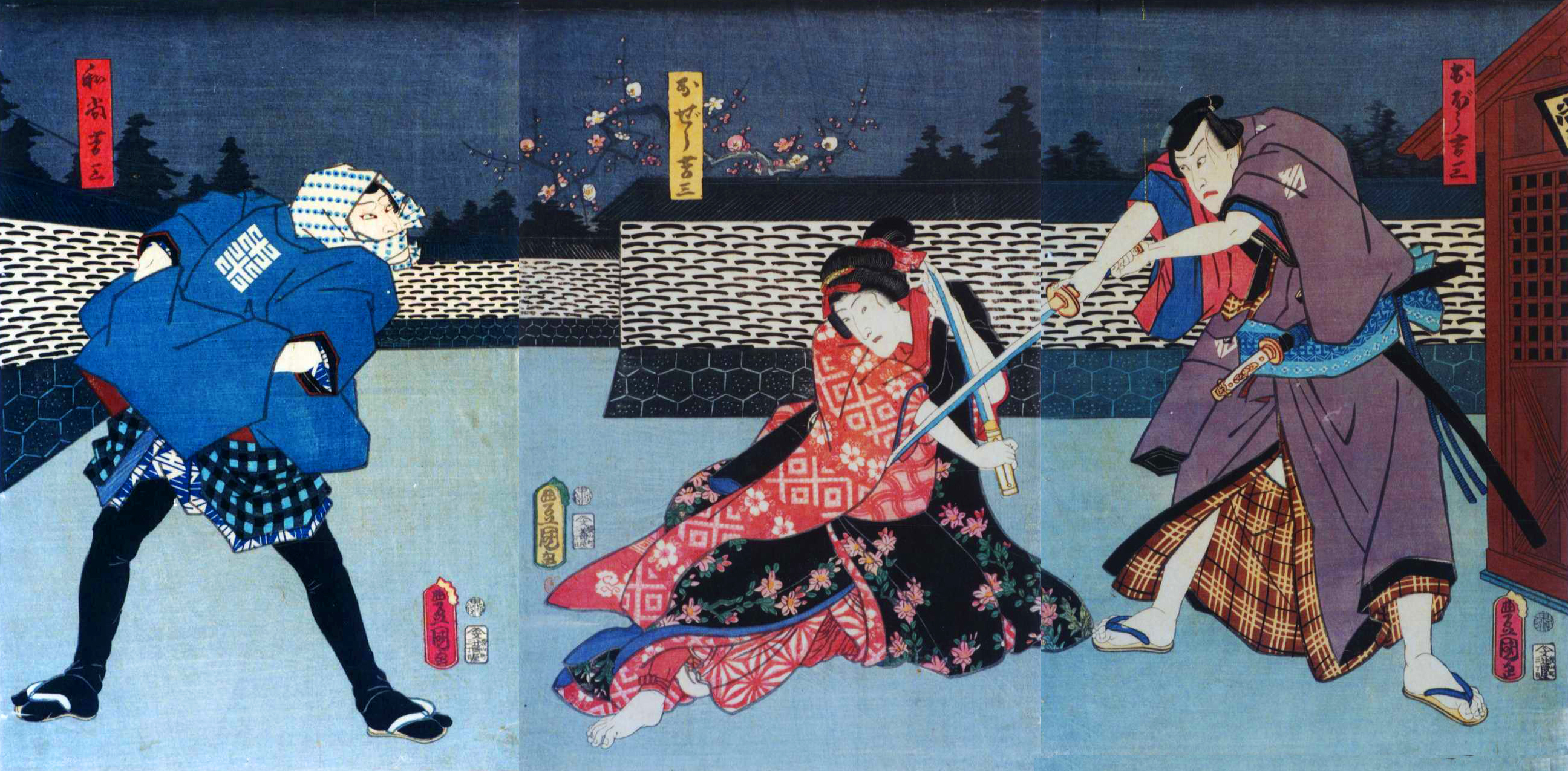
Kabuki is a traditional form of theatre in Japan which began around four hundred years ago. It is a highly stylized form of theatre, and its use of props is very formalized and full of tradition. I thought it would be interesting to take a look at how they use and make props in Kabuki. I don’t speak or read Japanese, so while I took care to double and triple-check all the terminology, someone more knowledgeable than I may still find mistakes. Still, I hope you’ll find what follows to be a good overview of props in Kabuki theatre.
Terminology
The word for props is å°é“å…·, or kodÅgu. Kabuki distinguishes between different categories of props just like those of us in English-speaking countries. If you need a refresher, check out my article on the different categories of props, as well as an illustration of these categories. Hand props are called æŒã¡é“å…·, or mochidÅgu. MochidÅgu include accessories, swords and other weapons, fans and armor (or yoroi); basically, everything which is portable. Set props, such as furniture, set dressing and other items left on stage for the duration of the performance, are known as dedÅgu. Large props are named 大é“å…·, or ÅdÅgu. In the US, we would consider ÅdÅgu to be scenery; indeed, the Japanese treat it as a separate department as well, with different technicians involved, so we will not spend any more time on it here.
Props which are used up at each performance (consumables and food) are called kiemono. Props which are broken and destroyed each performance are kowaremono. Vehicles and portable shrines are known as norimono. Rigged and trick props are called shikake, or shikake mono. A great example of a shikake mono is a branding iron with a button-activated electric filament which ignites a match head to produce a puff of smoke. Red paint on the iron also serves to leave a red mark on the actor being branded (McNicol 33). Kabuki also considers several other items to fall under the realm of props, such as animal costumes (nuigurumi), footgear (hakimono) and headgear. Unlike in the US, snow, snowflakes and artificial blossoms (tsuri eda) are responsibility of ÅdÅgu, rather than the prop makers (Scott 155).
Among the most difficult props to make are the decapitated heads, known as 首 (kubi) or kirikubi. Kubi are divided up into dakubi, or “low-class” head, and jÅkubi, or “high-class” head. Dakubi are usually cotton forms stuffed with wood shavings, sometimes covered in Japanese paper, with crudely painted features and hair. The neck may have a piece of red cloth attached. JÅkubi are more realistic and well-made. They can be carved out of oak or paulownia wood, or made of papier-mâché over a wooden base (hariko no kubi). The construction of these were reserved for master carvers, who attempted to capture the exact likeness of whichever actor it was supposed to represent. Examples of jÅkubi from the Meiji era (1868-1912 CE) still remain in existence at the Fujinama warehouse (more on Fujinama in a bit).
Despite its more formal classification of props, Kabuki is not immune to the age-old question of “is it a prop, or scenery (or costume)?” In a play called “Eihon Taikoki”, a warrior named Misuhide takes a stake from a bamboo thicket and sharpens it into a weapon. In this case, the odÅgu department constructs the thicket, while the kodÅgu department makes the stake (Scott 143). Surely, there is discussion and collaboration in determining these distinctions.
Fujinami Kodogu
A discussion of props in Kabuki is incomplete without a look at Fujinami Kodogu, or the Fujinami Props Co., Ltd. They are the sole supplier of Kabuki props in Japan (McNicol 30).

At one time, the kodÅgu were made in each theatre. In 1855, a massive earthquake destroyed nearly all of Edo (modern-day Tokyo), including the prop storage of the Ichimur Theater in Asakusa. Seeing an opportunity, a man named Yohei Fujinami began collecting and storing all sorts of items which could be rented for use onstage. This was also the time of the Meiji Ishin (Meiji Restoration), when the new Emperor required all Samurai to sell off family-owned possessions such as armor, swords, screens and tea ceremony utensils. Fujinami began buying these up as well. In 1872, he officially opened the Fujinami Kodogu in the midst of the city’s theatre district. It was the first enterprise of its kind in Japan (Hirata 46).
Fujinami began constructing a nearly impenetrable kura storehouse for his massive collection in 1896, complete with reinforced steel doors and meter-thick walls (McNicol 30). His planning and foresight paid off, as the structure survived the Great Kanto Earthquake of 1923. During the American air raids against Tokyo in World War II, Fujinami’s warehouse and the Matsuya department store were two of the only vertical structures to remain along riverbank east of central Asakusa. Kabuki performances were able to resume 16 days after the Japanese surrendered to the Allies in large part because so many of the props and stage necessities were preserved in the warehouse (Hirata 47).
During the war, the company was run by Fujinami Yohei III, grandson of the original Fujinami. He wrote and published many articles on his work and experiences in the theatre, and was well-renowned for his armor-reconstruction skills (Scott 148). After the war, he found it harder to find highly-skilled craftsmen, and was pressured to decrease the quality of his work to cut costs. Perhaps this is why he committed suicide in 1952, leaving behind a note which read, “I can do no more so I go” (Scott 149).
His son, Fujinami Yohei IV, took over the company. Today, the president is Isamu Tanaka. In addition to the central storehouse, the company has five warehouses in the Tokyo suburbs, where they store hundreds of thousands of props (McNicol 30), including over 10000 swords dating back 150 years (Hirata 47). The company has about 120 employees, with 20 of them artisans.
The Use of Props in Performance
A Kabuki theatre keeps the kodÅgu in a special room. The heya mono kata are the men who pull the props needed for each performance from here (Scott 144).
Stagehands are known as kÅken or kurogo. AÂ kÅken places a prop on stage only when it is needed, and removes it as soon as it is finished. This is done in full view of the audience with no attempt to hide or disguise the theatricality of the moment (Taylor 170).
A property master is known as a å°é“å…·æ–¹, or shÅ dÅgukata (sometimes anglicized as kÅdogu-kata). The shÅ dÅgukata manages, oversees and distributes the props based on the daily schedule (Petersen 267). He will join a production for its four to five day rehearsal period. During rehearsals and performances, he will place and remove props from the edge of the stage. He is the one responsible for checking and repairing props as they are used. If they need more than a quick-fix, he will send the note back to the prop shop. He also facilitates communication between the Kabuki actor and the Fujinami craftsmen (Hirata 47).
Kabuki is a highly stylized and formalized form of theatre, and thus some props are modified from their real-life counterparts for theatrical business. For instance, swords can be made to rattle by shaking them; Kabuki actors use this sound to convey aggression or nervousness (McNicol 31). An axe may have a secret compartment concealing makeup and a small mirror; the actors will use this for touching-up his face during long periods onstage (McNicol 32).
People
Props are constructed by the department known as the kosakuba. The types of craftsmen needed to construct props can include carpenters, carvers, sculptors, metal workers, armorers, lacquer workers, and painters (Scott 144). The Fujinami workshop is located on the second floor of the Asakusa headquarters (McNicol 32). As mentioned above, the Kabuki actors will give requests for props to the shÅ dÅgukata, who will then bring it to the craftsmen. The actor may designate the height of a chair seat, for instance, and then it is up to the craftsman to make a drawing and fill in the rest of the measurements (Hirata 47).
Many craftsmen inherit their skills from their fathers and grandfathers (Scott 148). Fujinami has its new employees go through a three-year apprenticeship, followed by a written test. Tanaka, the president, estimates it takes an artisan ten years to become fully-versed in all things Kabuki-prop related (McNicol 34). Though Japan’s retirement age is 60, Fujinami has had some artisans who have worked there well into their seventies and eighties. Recent ones include Matsuo Kajiro, sculptor, carver and mask-maker (Scott 149); Kazuo Takeuchi, furniture-maker (Hirata 47); and Kiyoshi Yamanaka, metal objects (McNicol 33).
The feudal system in Japan meant that the secrets of prop-making, such as formulas and patterns, were kept closely guarded (Scott 152). Students relied on the “stolen technique”, in which they watched a master in action for years; a master who actually taught a student their skills would lose his standing (McNicol 34). These days, the older generation is much more likely to share their knowledge and skills with the next generation so the younger generation can learn more efficiently (Hirata 47). Regular readers of this blog may recognize this concept in my own article about sharing and secret knowledge.
A props person may also be referred to as a kodÅgu-ya. This word can also refer to a dealer in second-hand furniture. Though props can be kept in use for decades, and even centuries, and artisans can build any number of items, kodÅgu-ya still need to buy certain props. Like their Western counterparts, they find these at antique fairs and from dealers (McNicol 32).
Materials
As previously mentioned, many traditional Kabuki props are made out of paulownia wood, also known in Japan as æ¡, or kiri. Paulownia is light-weight and strong with a straight, fine grain like balsa wood. It is also dimensionally-stable and resistant to warping, like MDF. It grows to maturity quickly like bamboo. These properties not only made it popular to the traditional craftsmen in years gone by, but also attractive to the modern artisan looking for more sustainable materials.
In addition to wood, other traditional materials include paper, papier-mâché and bamboo. Modern additions include resin, fiberglass and plastics. The choice for materials has much to do with the need for lightness in a kabuki prop. A mask can be constructed of up to 35 layers of  handmade Japanese washi paper. Because that paper is extremely strong along the grain, but tears easily across it, the strips of paper in each successive layer are laid perpendicularly to the one before it. This type of paper is so different from modern paper, Fujinami actually buys large quantities of antique books and old documents to tear apart for raw materials (McNicol 33). While papier-mâché is fine for fake food, historical armor and swords need to be reproduced with precise historical accuracy (Scott 144). A set of armor can take a skilled craftsman over six months to make. Though Fujinama once employed its own armor-makers, these days the work is done mainly by outside artisans (McNicol 31-2).

In his own writings, Fujinami Yohei III describes a lion’s head mask which is father had worked with in 1893. It was carved from paulownia wood in the fashion of a Nara doll. The chisel marks were left visible, and the varnish was put on so as as not to obscure them. Its eyes were jade balls, and the lower part of its teeth were gilded with gold dust. The lower jaw could be moved freely using the thumb. Fujinami III ventured a guess that it was made by an artisan named Yasumoto Kamhachi I (Scott 150). Fujinami III then goes on to describe how his father made a duplicate of this mask:
Thereupon Yohei summoned Kobayashi Masakichi, who was a master craftsman in his employ, and ordered him to make a mould of the lion’s head. For this purpose Kobayashi used a modelling apparatus such as dentists use for the making of tooth moulds, and obtained a concave mould of the original. Next he poured plaster into it and produced an exact model of Danjuro’s treasure. With this plaster model by his side, Kobayashi set to work on a block of Nambu paulownia wood and finally perfected a lion’s head which in every detail reproduced the characteristics of its prototype (Scott 151).
Because the Fujinami warehouse survived throughout this time period, these lion head masks are still around today.
Bibliography
“Crafting the Past”, by Nobuko Hirata. iNTOUCH, December 2009.
“Kabuki Props“, by Tony McNicol. Wingspan, March 2007.
An Invitation to Kagura: Hidden Gem of the Traditional Japanese Performing Arts, by David Petersen. Published by David Petersen, 2007.
The Kabuki Theatre of Japan, by Adolphe Clarence Scott, Courier Dover Publications, 1999.
“Yoshitsune Senbon Zakura: The Visual Dimension in a Kabuki Performance”, by Beverly Angelique Taylor, December 1995. University of Hawaii dissertation, department of Philosophy.






That’s a mold-braeekr. Great thinking!